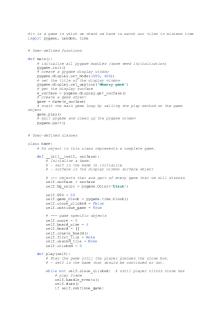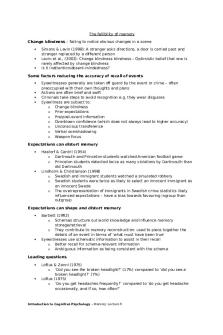Sensory Memory - Professor David Rapp PDF

| Title | Sensory Memory - Professor David Rapp |
|---|---|
| Author | courtneyma NA |
| Course | Cognitive Psychology |
| Institution | Northwestern University |
| Pages | 4 |
| File Size | 86.2 KB |
| File Type | |
| Total Downloads | 36 |
| Total Views | 128 |
Summary
Professor David Rapp...
Description
Visual Search CogLab results: slower in absent condition, with more distractors, conjunction search Info processing model/box model: explains how STM, LTM, sensory memory interact ● STM: here and now ● LTM: all info you have ever learned, much bigger than STM Sensory memory ● Where immediate, instant info comes into the system -- starting point ● First part of info processing model ● Some info goes to conscious recognition, but other info doesn’t... how and why? ● AKA sensory register, sensory store ● Preservation of sensory info for short periods ● Raw, unprocessed, uncategorized format Visual = iconic memory ● Icon: visual picture that represents an object, role is to store visual info for a brief period of time that you can attend to ● Visual sensory memory ● Visual persistence: persistence of a visual stimulus beyond its physical duration (wobbling pencil) Sperling (1960) ● How much info can the visual system take in, and how long does it hold it? ● Whole report procedure: present a series of stimuli, ask subject to provide all info from the array that they remember ○ People tend to accurately recall 4-5 out of 12 letters ○ Memory diminishes over time (fades/decays), leading to response limitation ● Partial report procedure: present a series of stimuli, ask subject to provide info from part of the array that they remember ○ People remember 2-4 out of 4 letters from each row that they were cued to report on ○ Thus, they remember 6-9 letters out of 12 total ○ We remember more letters than we think when we don’t know what we will be asked on ● Tachtistoscope (t-scope) to rapidly present images ● Subjects saw 3x4 grid of letters presented for 50 msec ● Whole report: recall all letters - 12 possible items ● Partial report: recall letters from 1 row - 4 possible items ● Number of items we could remember is higher in partial report than whole report procedure ● Why don’t we remember as much in the whole report procedure? ○ Recalling a letter interferes with memory of the subsequent letters in sensory memory ○ When we start saying letters, the ones in our memory go away ○ More delay of tone = more decay
● Immediate: partial report is more accurate than whole report ● Delay: partial report accuracy drops quickly -- after 1 second, accuracy is the same as in whole report ● Rehearsal of letters interferes with sensory memory for letters you haven’t yet rehearsed Human info processors have a brief, large capacity for sensory stimuli of a visual nature ● Sperling called this the iconic store/icon. ● Ecological validity: how relevant is the icon to real-world perception? ○ Visual images are continuous ○ Haber: notion of icon cannot be useful in any typical visual info processing task except reading in a lightening storm ● Decay/fading is the loss mechanism involved in iconic memory ● Info remains in iconic memory for approximately 1 second Averbach and Coriell (1961) ● Examined output interference effects using one-letter responses ● Used a visual cue after presentation of 2 rows of letters ○ Bar above target position ○ Ring around target position -- does this interfere with memory for the letters? ● When cue was presented above target position, letter recay decreased with decay ● When cue was presented around target position, letter recall was poor even with no decay ● Cue functions like a visual mask ● Backward masking: when later visual stimulus interferes with perception of an earlier one Why do images fade from iconic memory? ● Image decay over time and interference from later images ● Iconic memory is an initial (and very fast) step in perception -- precategorical info What about “meaning” info? -- Wright (1972) ● Use partial report technique, but... ○ Use cues that rely on physical features (color, location) of array ○ Use semantic info -- letter/digit, vowel/consonant ● If sensory memory is pre-cognitive, then we should not see semantic processing having influence on partial report procedure ● We are better at naming if we have to rely on physical features than if we have to rely on meaningful info Pre-categorical ● Little to no processing at semantic level ● Meaning is ascribed to info after it gets passed sensory memory ● “Representation” is raw sensory info
● Partial report advantage for precategorical features because they are “in” the icon ● No partial report advantage for categorical factors because they require more processing (not done in icon) External/ecological validity: degree to which lab tasks resemble “real world” cognition How might the icon be used in real perception? ● Perception of motion: briefly retain motion info in complex dynamic displays ● Saccadic suppression: during saccades we are functionally blind; icons may help integrate info across saccades Iconic memory ● immediate store of visual info ● Duration 0.5-1 sec ● large capacity, but difficult to measure ● pre-categorical representation Auditory = echoic memory ● maintenance of a representation of auditory stimulus for a brief time ● Darwin, Turvey, and Crowder (1972): like Sperling’s partial report technique for auditory stimuli ○ “3-eared man” procedure: simultaneous presentation of 3 lists of items through headphones at different spatial locations ○ Light indicates which set to recall ○ At short delays, partial report was better than whole report ○ Max # of items recalled was 5 ● Duration 2-4 seconds ● Immediate store of info ● Capacity: large, but hard to measure sensory input --> sensory store/sensory memory --> recognition --> to memory Role of sensory memory ● Integrates info across time and space ● Brief record permits selection for further processing -- filter models ● Provides coherence and stability despite constant receptor changes How do we lose info from sensory memory? ● May have never entered into first place ● Fading/decay ● Interference
Summary ● Bottom-up processing -- stimuli from environment ● Pre-cognitive -- raw info ● Large capacity, limited duration ● Attention determines whether info will transfer to more permanent stores...
Similar Free PDFs

421 Sensory - Professor Quay
- 9 Pages

Laporan KP PT. RAPP
- 104 Pages

Memory
- 3 Pages

Memory
- 5 Pages

Introduction to Sensory Systems
- 4 Pages

7. sensory motor intergration
- 6 Pages

IA24 Sensory ganglion
- 1 Pages

Virtual Memory
- 58 Pages

CACHE MEMORY
- 1 Pages
Popular Institutions
- Tinajero National High School - Annex
- Politeknik Caltex Riau
- Yokohama City University
- SGT University
- University of Al-Qadisiyah
- Divine Word College of Vigan
- Techniek College Rotterdam
- Universidade de Santiago
- Universiti Teknologi MARA Cawangan Johor Kampus Pasir Gudang
- Poltekkes Kemenkes Yogyakarta
- Baguio City National High School
- Colegio san marcos
- preparatoria uno
- Centro de Bachillerato Tecnológico Industrial y de Servicios No. 107
- Dalian Maritime University
- Quang Trung Secondary School
- Colegio Tecnológico en Informática
- Corporación Regional de Educación Superior
- Grupo CEDVA
- Dar Al Uloom University
- Centro de Estudios Preuniversitarios de la Universidad Nacional de Ingeniería
- 上智大学
- Aakash International School, Nuna Majara
- San Felipe Neri Catholic School
- Kang Chiao International School - New Taipei City
- Misamis Occidental National High School
- Institución Educativa Escuela Normal Juan Ladrilleros
- Kolehiyo ng Pantukan
- Batanes State College
- Instituto Continental
- Sekolah Menengah Kejuruan Kesehatan Kaltara (Tarakan)
- Colegio de La Inmaculada Concepcion - Cebu






